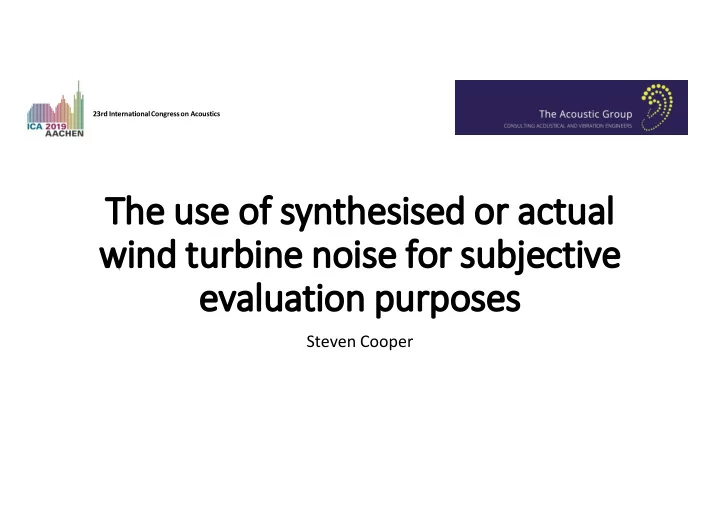

23rd International Congress on Acoustics The use The use of of synthesised synthesised or or actual actual wind wind turbine turbine noise noise for for subjective subjective evaluation evaluation purposes purposes Steven Cooper
CBW Turbine 13 at 14% power FFT (0-1 kHz, 400 lines) FFT vs Time (0-1 kHz, 400 lines) A-weighted Time Splice
Kelley N.D., Hemphill R.R. and McKenna H.E. A Methodology for Assessment of Wind Turbine Noise Turbine noise emission components with building and human body resonances superimposed
Cape Bridgewater Wind Farm, House 87 Bedroom, 5:30 am 22 May 2014, L eq, 10 minute FFT (1600 lines) 0 – 25 Hz 0 – 1 kHz
100Hz (100ms, 1Hz Burst) - Generator (Free Running Trigger) (Real) [dB/1 V] -40 100 Hz 100 ms Burst -60 Generator (Real) [V] -80 0.24 0.2 -100 0.16 0 100 200 300 400 500 600 700 800 900 1k 0.12 [Hz] 100Hz (100ms, 1Hz Burst) - Generator (Real) 80m [dB/1 V] -60 40m 0 -70 -40m -80m -80 -0.12 -0.16 -90 -0.2 -0.24 -100 0 40m 80m 0.12 0.16 0.2 0.24 0.28 0.32 0.36 0 4 8 12 16 20 24 [s] [Hz]
Shirley Wind Farm Report with manufacturers frequency response of speaker used in Crichton paper shown in orange trace
Walker B & Celano J “Progress Report on Synthesis of Wind Turbine Noise and Infrasound” Original Waveform Walker Synthesised Waveform Original FFT (1600 lines, 0-25 Hz)
Cooper Results (field measurements) Tonin Results (synthesised) Waveform FFT (0-25 Hz, 1600 lines)
Annexure D of ANSI/ASA S12.9-2016/Part 7 “Advanced Signal Processing Techniques” It has been observed (Bray, Swinbanks, Walker, et al) that for complex low-frequency signals (those comprising multiple frequencies), the temporal relationship between the components can have a significant influence on their subjective assessment. (Indeed, al one needs do is listen to the difference between a gun-shot and an extended Galois sequence signal to observe the two signals with the exact same spectrum can sound dramatically dissimilar.)
Line Array Speaker System (2.5 inch drivers) showing the Cape Bridgewater signal
Conclusion • Testing of wind turbine infrasound should use actual signals of wind turbines and not a tone or a synthesised signal • Infrasound levels attributed to wind turbine noise are less than the threshold of audibility for constant tones and therefore should be inaudible. • Why test for infrasound only when wind turbine noise contains frequencies in the audible spectrum? • The infrasound signature obtained by narrowband FFT analysis is the result of an analysis of transient pulses that can be derived by modulating sounds of much higher frequency • For testing of wind turbine noise (including infrasound?) in a more practical sense, would be easier and realistic to simply use wave file recordings
Recommend
More recommend